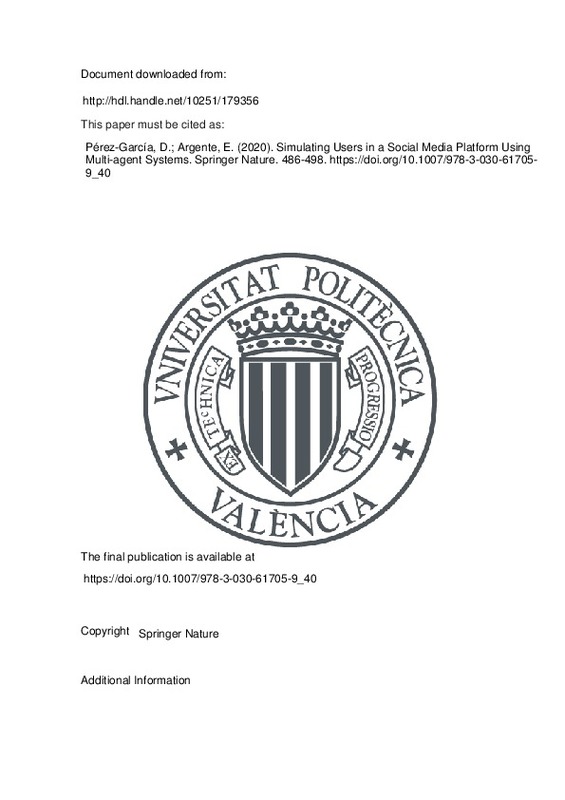Alemany, J., del Val, E., Alberola, J., García-Fornes, A.: Enhancing the privacy risk awareness of teenagers in online social networks through soft-paternalism mechanisms. Int. J. Hum.-Comput. Stud. 129, 27–40 (2019)
Argente, E., Vivancos, E., Alemany, J., García-Fornes, A.: Educando en privacidad en el uso de las redes sociales. Educ. Knowl. Soc. 18(2), 107–126 (2017)
Bell, L., Gustafson, J.: Interaction with an animated agent in a spoken dialogue system. In: 6th European Conference on Speech Communication and Technology (1999)
[+]
Alemany, J., del Val, E., Alberola, J., García-Fornes, A.: Enhancing the privacy risk awareness of teenagers in online social networks through soft-paternalism mechanisms. Int. J. Hum.-Comput. Stud. 129, 27–40 (2019)
Argente, E., Vivancos, E., Alemany, J., García-Fornes, A.: Educando en privacidad en el uso de las redes sociales. Educ. Knowl. Soc. 18(2), 107–126 (2017)
Bell, L., Gustafson, J.: Interaction with an animated agent in a spoken dialogue system. In: 6th European Conference on Speech Communication and Technology (1999)
Cassell, J., Thorisson, K.R.: The power of a nod and a glance: envelope vs. emotional feedback in animated conversational agents. Appl. Artif. Intell. 13(4–5), 519–538 (1999)
Cerrato, L., Ekeklint, S.: Different ways of ending human-machine dialogues. In: Proceedings of the Embodied Conversational Agents (2002)
Franchi, E., Poggi, A.: Multi-agent systems and social networks. In: Handbook of Research on Business Social Networking: Organizational, Managerial, and Technological Dimensions, pp. 84–97. IGI Global (2012)
Hollenbaugh, E.E., Ferris, A.L.: Facebook self-disclosure: examining the role of traits, social cohesion, and motives. Comput. Hum. Behav. 30, 50–58 (2014)
Hubal, R.C., Fishbein, D.H., Sheppard, M.S., Paschall, M.J., Eldreth, D.L., Hyde, C.T.: How do varied populations interact with embodied conversational agents? Findings from inner-city adolescents and prisoners. Comput. Hum. Behav. 24(3), 1104–1138 (2008)
Inc., F.: Facebook reports third quarter 2019 results (2019). https://investor.fb.com/investor-news/press-release-details/2019/Facebook-Reports-Third-Quarter-2019-Results/default.aspx . Accessed 27 Jan 2020
Inc., F.: Instagram for business (2019). https://www.facebook.com/business/marketing/instagram . Accessed 27 Jan 2020
Inc., T.: Twitter q3 ’19 investor fact sheet (2019). https://s22.q4cdn.com/826641620/files/doc_financials/2019/q3/Q3_19_InvestorFactSheet.pdf . Accessed 27 Jan 2020
Kökciyan, N., Yolum, P.: PriGuardTool: a tool for monitoring privacy violations in online social networks. In: AAMAS, pp. 1496–1497 (2016)
Lewis, K.: The co-evolution of social network ties and online privacy behavior. In: Trepte, S., Reinecke, L. (eds.) Privacy Online, pp. 91–109. Springer, Heidelberg (2011). https://doi.org/10.1007/978-3-642-21521-6_8
Madden, M., et al.: Teens, social media, and privacy. Pew Res. Cent. 21, 2–86 (2013)
Patkos, T., et al.: Privacy-by-norms privacy expectations in online interactions. In: 2015 IEEE International Conference on Self-Adaptive Self-Organizing Systems, pp. 1–6 (2015)
Ruiz Dolz, R.: An argumentation system for assisting users with privacy management in online social networks (2019)
Spottswood, E.L., Hancock, J.T.: Should I share that? Prompting social norms that influence privacy behaviors on a social networking site. J. Comput-Mediat. Commun. 22(2), 55–70 (2017)
Stutzman, F., Kramer-Duffield, J.: Friends only: examining a privacy-enhancing behavior in facebook. In: Proceedings of the SIGCHI Conference on Human Factors in Computing Systems, pp. 1553–1562 (2010)
Waters, S., Ackerman, J.: Exploring privacy management on Facebook: motivations and perceived consequences of voluntary disclosure. J. Comput-Mediat. Commun. 17(1), 101–115 (2011)
Wisniewski, P.J., Knijnenburg, B.P., Lipford, H.R.: Making privacy personal: profiling social network users to inform privacy education and nudging. Int. J. Hum.-Comput. Stud. 98, 95–108 (2017)
[-]







![[Cerrado]](/themes/UPV/images/candado.png)


